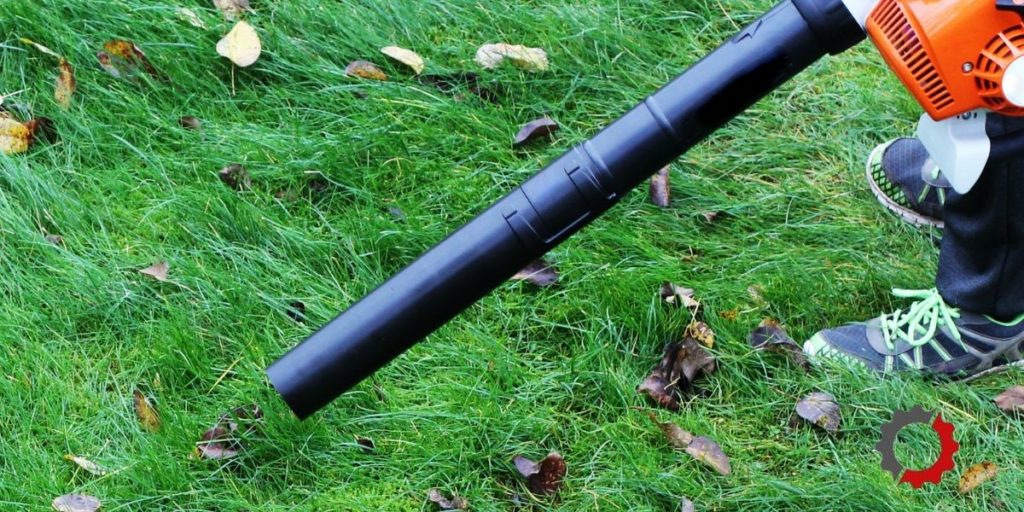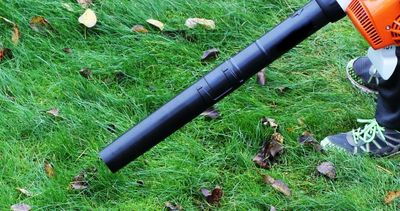You have a big project to tackle with your leaf blower, but it’s not giving you the power you are used to. It’s having a hard time blowing leaves across the yard. If you don’t get this problem fixed, you may end up having to use a garden rake making your job a lot more labor intensive.
A leaf blower runs rough when old or dirty gasoline is causing clogging in the fuel line, fuel filter and carburetor; the fuel tank vent is plugged; the spark plug is bad; the air filter is dirty; or the spark arrestor is plugged.
Don’t forget to remove the spark plug and wait for all moving parts to stop before working on your leaf blower. Follow the safety instructions provided in your owner’s manual. Consult an experienced mechanic if you are unsure how to safely perform a task.

This post may include affiliate links. Purchases made through these links may provide a commission for us, at no extra cost to you. As an Amazon Associate, we earn from qualifying purchases.
Follow all safety instructions provided in your equipment operator’s manual prior to diagnosing, repairing, or operating.Consult a professional if you don’t have the skills, or knowledge or are not in the condition to perform the repair safely.
8 Reasons Your Leaf Blower is Running Rough
Old or Bad Fuel Causes a Leaf Blower to Run Rough
Running gasoline that isn’t fresh and has been sitting around in a storage can or your leaf blower can cause running problems.
Most types of gasoline on the market today contain ethanol, an alternative fuel added to gasoline to make it more environmentally friendly. While this type of fuel is okay to use in most vehicles, ethanol is not friendly to the small engine in your leaf blower.
Ethanol attracts moisture to the fuel system which can leave behind varnish and gummy deposits that clog the fuel system and prevent the carburetor from functioning correctly.
Use unleaded gasoline with a minimum octane-rating of 89 and a maximum ethanol content of 10%. The less ethanol in the gasoline, the better.
Because gasoline breaks down as quickly as 30 days after purchase, it’s important to use fresh gas and consume it within this time frame. If you are unable to use a tank of fuel this quickly, add a fuel additive like Sea Foam to stabilize it and reduce the negative effects of fuel.
Most leaf blowers used today have a 2-cycle engine that requires gasoline and oil to be mixed before filling the fuel tank. You will also find some 4-cycle leaf blowers in use. Oil and gas are not mixed for these types of engines.
Adding the wrong type of fuel to your leaf blower can damage the unit beyond repair. The same is true if you don’t use the proper gas and oil mix in a 2-cycle engine. Read more about this in, “This is the Type of Gas and Oil to Use in a Leaf Blower“.
Dirty Spark Plug Causes a Leaf Blower to Run Rough
A dirty or damaged spark plug can cause it to misfire resulting in the leaf blower running rough. A loose spark plug wire or incorrect gap can also be responsible for a poorly running leaf blower that bogs down and doesn’t run strong.
Remove the spark plug using a socket wrench. Check its condition. Replace the spark plug if you find the tip is very dark in appearance, the porcelain is cracked or the electrode is burnt.
If you find your spark plug is just dirty, clean it with a wire brush or replace it with a new spark plug.
I prefer to use a new spark plug since it is a crucial component to having a leaf blower operating at its best. Make sure you have a properly gapped spark plug using a feeler gauge. Install the new or clean spark plug and securely attach the spark plug wire.
Plugged Fuel Filter Causes a Leaf Blower to Run Rough
The fuel filter attaches to the end of the fuel line and sits in the fuel tank. Fuel is filtered to prevent dirt and debris from entering the fuel system.
When the filter becomes clogged so a good steady flow of fuel isn’t able to pass through the filter, the blower will begin to run rough because it isn’t getting sufficient fuel.
A plugged fuel filter must be replaced. Set the leaf blower on a flat surface, and remove the fuel tank cap. Pull the fuel filter out of the tank.
You may want to use a clean bent wire to “fish” the filter out of the tank. Holding the fuel line and ring clip in one hand, securely grab the filter and pull it out of the fuel line.
Do not lose the ring clip and keep it on the fuel line. Install a new fuel filter into the end of the fuel line. Slide the ring clip so it sits over the fuel line and fuel filter male end to secure the filter to the line.
Clogged Fuel Lines Cause a Leaf Blower to Run Rough
Old fuel can clog the leaf blower’s fuel line restricting fuel flow. Look for a clogged line or a line that may have gotten pinched or kinked. Replace any damaged or clogged fuel line with a new piece of fuel line of the same length and diameter.
Plugged Fuel Tank Vent Causes a Leaf Blower to Run Rough
The fuel tank vent can become plugged or damaged preventing air from passing through the vent to equalize the air pressure in the fuel tank. A plugged vent can cause a vacuum to form in the fuel tank. This keeps fuel from flowing out of the tank.
If fuel isn’t running through the fuel lines and you don’t have a clogged line or a plugged fuel filter, there is a good chance the fuel tank vent is plugged. You can test this by loosening or removing the blower’s fuel cap to allow air into the tank. Start the blower, and allow it to run.
Be careful and keep your leaf blower level so you don’t spill any gas from the tank. If the blower runs strong and doesn’t bog down and run rough, tighten the fuel cap and see if you can replicate the issue to confirm the fuel tank vent is the problem.
Replace the fuel tank vent if your blower starts to act up and run rough again after installing the fuel cap.
Plugged Air Filter Causes a Leaf Blower to Run Rough
The engine requires air to run. Without enough air, the leaf blower will run sluggish and rough. One of the items that can restrict airflow is a plugged air filter. The air filter can become plugged from dirt and debris when not regularly cleaned and changed.
If you find your air filter is plugged, I recommend replacing the filter. The small air filter is usually not very expensive. It is an important component when it comes to protecting the engine.
A foam, fabric, or felt-style filter can be cleaned using mild dish soap and water. Wash the filter to remove as much dirt as possible. Rinse until clear.
A paper filter can be cleaned by knocking it against a solid surface to remove as much dirt as possible. Hold it up to a light source to see if you can see light through the element. Reuse the filter if you can still see light. Replace the filter if you cannot see light, your filter is very dirty or it is covered in oil.
Because there are so many different types of filters used which varies by manufacturer and model of the blower, refer to your operator’s manual for steps to clean the style of air filter in your leaf blower.
Dirty Carburetor Causes a Leaf Blower to Run Rough
The carburetor mixes the correct proportion of air and fuel needed for your leaf blower to run. The passageways can become clogged and the small components can fail to function correctly.
This can cause an insufficient amount of fuel mixed with air resulting in a rough running leaf blower.
You may be able to clean your carburetor to get it working again. You may end up having to rebuild (if rebuild kits are available for your carburetor) or replace the carburetor if cleaning doesn’t help.
Plugged Spark Arrestor Causes a Leaf Blower to Run Rough
There is a small metal screen that keeps hot exhaust material from shooting out of the leaf blower and causing injury or starting a fire. This small screen will become plugged with a carbon buildup that will affect how the engine runs.
Disconnect the spark plug wire. Remove the engine cover and the engine exhaust cover. Carefully remove the spark arrestor screen. Clean the screen with a metal brush and reinstall it. Reattach the engine exhaust cover and engine cover. Reattach the spark plug wire.
If the screen isn’t able to be sufficiently cleaned or you find it is damaged or has a hole in it, replace it with a new spark arrestor screen.
